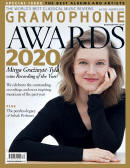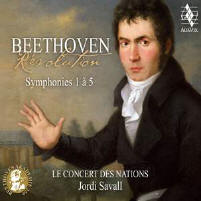Texte paru dans: / Appeared in: |
|
| ‘Enjoy’ is the word for the set as a whole. |
Outil de traduction (Très approximatif) |
|
Reviewer: Peter Quantrill We know a lot about how Beethoven composed at the keyboard, and right from the clipped, slashed and rolled tutti chords of the First Symphony’s opening-movement Allegro, all weighted according to context by Le Concert des Nations, there’s a fine and rare sense of how his thinking transferred itself to an orchestral canvas. Made under studio conditions in the church of a medieval Catalonian fortress, these recordings enjoy plenty of string bass colour and timpani impact without swamping the liveliest inner-part debates between solo winds or divided-violin combat. ‘Enjoy’ is the word for the set as a whole. The tempos are largely Beethoven’s own, at least according to the metronome marks he retrospectively applied in 1809 to all the symphonies he had composed up to that point, but almost no interpretative decision feels insisted upon, no expressive horizon foreshortened by a ready-made frame. The Second is a particular success, its long Larghetto moulded by Savall’s cultivation of a genuine pianissimo and some rosy-hued contributions from clarinets and horns. Without resort to opera buffa stereotypes, the Scherzo and finale take a genial tone while hinting at might and resolve in reserve: Prince Hal to the Eroica’s Henry V. Judged by the highest standards – Carlos Kleiber live in Munich (Orfeo, 6/85), Frans Brüggen live in Rotterdam (Glossa, 1/13) – the pathos of the Fourth’s Adagio is slightly hemmed in by the happy tick-tocking of its opening phrases, and the crescendo up-beat at 0'25" is quite crudely done, but Savall establishes a powerful tension between martial and lyrical modes that anticipates the weightier contrasts of the Fifth’s Andante con moto and more immediately discharges its accumulated energy into a tautly sprung account of the Scherzo, so that – Beethoven’s influence on symphonic Schubert and Bruckner writ large – the only point of genuine repose in the symphony arrives with the bucolically relaxed Trio. As for the Eroica and the Fifth – which Savall originally programmed in harness, remarkably without compromising either the reach of the Funeral March or the elated new dawn of the Fifth’s finale – I fancy that no Toscanini devotee will find themselves short-changed by the remorselessly pursued logic of the Third’s gigantic opening panel, just as Furtwängler admirers will appreciate the uncanny space, the storm and the stress of the Fifth’s repeat-heavy Scherzo, while enjoying some turns of phrase that are all Savall’s own as well as a pair of tiny but telling violin tremolos (6'54") in the build-up to the finale that pass for nothing on almost every other recording. And, mercifully, Savall’s contrabassoonist is unafflicted by the noisy key action that disfigures the Currentzis recording at this point (Sony, 4/20). In fact I note that she (Katalin Sebella) manufactures her own reeds and, like several other members of Le Concert des Nations including the assistant leader Manfredo Kraemer, has long experience with other period-instrument luminaries in this repertoire such as the late Nikolaus Harnoncourt. But there is no mistaking the exercise of Savall’s collegiate authority over these superbly articulate new recordings, which are far more finished articles than his previous essays at Nos 3 and 5 (Auvidis, 7/97), nor the far-ranging imagination informed by exploring musical regions as distant as Sufi chant and Celtic fiddle tunes, applied now to the most central repertoire of all. If the pandemic does not put paid to the planned second volume, the completed set should rank alongside Brüggen and Mackerras (Hyperion, A/07) among the most distinguished Beethoven cycles of the new century. |
|




